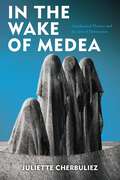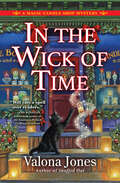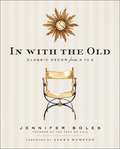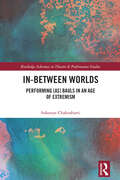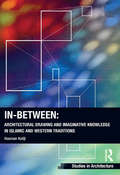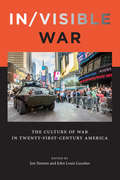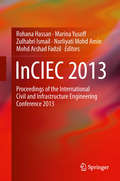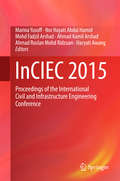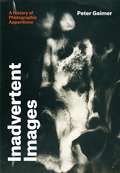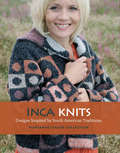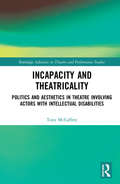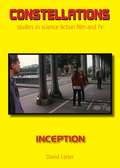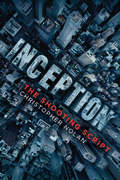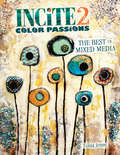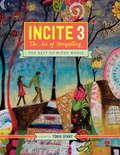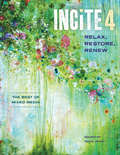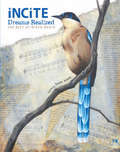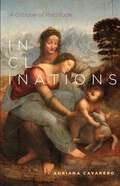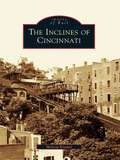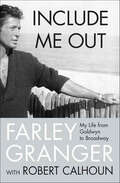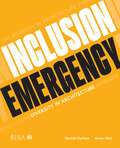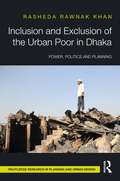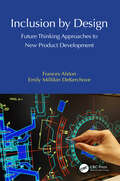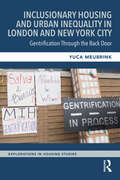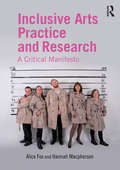- Table View
- List View
In the Wake of Medea: Neoclassical Theater and the Arts of Destruction
by Juliette CherbuliezIn the Wake of Medea examines the violence of seventeenth-century French political dramas. French tragedy has traditionally been taken to be a passionless, cerebral genre that refused all forms of violence. This book explores the rhetorical, literary, and performance strategies through which violence persists, contextualizing it in a longer literary and philosophical history from Ovid to Pasolini.The mythological figure of Medea, foreigner who massacres her brother, murders kings, burns down Corinth, and kills her own children, exemplifies the persistence of violence in literature and art. A refugee who is welcomed yet feared, who confirms the social while threatening its integrity, Medea offers an alternative to western philosophy’s ethical paradigm of Antigone. The Medean presence, Cherbuliez shows, offers a model of radically persistent and disruptive outsiderness, both for classical theater and for its wake in literary theory.In the Wake of Medea explores a range of artistic strategies integrating violence into drama, from rhetorical devices like ekphrasis to dramaturgical mechanisms like machinery, all of which involve temporal disruption. The full range of this Medean presence is explored in treatments of the character Medea and in works figuratively invoking a Medean presence, from the well-known tragedies of Racine and Corneille through a range of other neoclassical political theater, including spectacular machine plays, Neo-Stoic parables, didactic Christian theater. In the Wake of Medea recognizes the violence within these tragedies to explain why violence remains so integral to literature and arts today.
In the Wick of Time (Magic Candle Shop Mystery #2)
by Valona JonesTabby Winslow will help her twin sister Sage with anything and everything—and that includes putting out the flames of suspicion when Sage&’s boss is found murdered in this magical mystery, perfect for fans of Amanda Flower and Sofie Kelly.December in Savannah, Georgia, is a sight to behold. With all the festivities—including the traditional riverfront luminary display during the boat parade—twin sisters Tabby and Sage Winslow are busier than ever setting up for the big celebration. But that isn&’t the only thing on the sisters&’ minds. Both Sage and her fellow employee Mary Nicole are vying for the sought-after assistant manager job at the plant nursery. But when Loren Lee, their boss, is found dead, and Sage becomes the police&’s favorite suspect, both Winslow girls know that they&’ll need more than a flicker of magic and their sisterhood to solve the murder and clear Sage&’s name.Soon, Tabby realizes that this is just one of the many problems they have. If being a suspect for murder wasn&’t enough, there are more magical problems that they have to fix: Sage&’s boyfriend is having a paranormal experience of his own he can&’t control, there&’s an energy vampire searching for his supposedly lost cousin, her cat suddenly dislikes her, and oh—every time Tabby hiccups, she turns completely invisible. The suspect list grows with each day and it seems everyone has a reason or a connection to Loren Lee. Tabby and Sage are burning the candle at both ends—but will it be enough to keep their friends safe and find this killer? Or will they be burned by their efforts?
In with the Old: Classic Decor from A to Z
by Jennifer BolesThe Peak of Chic blogger Jennifer Boles--who counts Newell Turner, Alexa Hampton, Stephen Drucker, and Veranda founder Lisa Newsom among her loyal readers--presents a charming encyclopedia of 100 of the most stylish decorating details (chintz, striped walls, and orangeries) that were favored by the great tastemakers of the twentieth century. Best of all, Jennifer gives helpful tips on decorating with these traditional flourishes today.The 1930s to the 1960s were a grand time for decorating: they saw Chippendale chairs and grotto furniture, house stationery, monograms, tented rooms, and vanities--much of which has since been forgotten or taken for granted. In In with the Old Jennifer Boles breathes new life into gracious living with 100 entries organized from A to Z on her favorite decorating essentials of the past. Each entry explores curious facts, anecdotes, and timeless advice plucked from the legacies of Billy Baldwin, Dorothy Draper, Sister Parish, the Duchess of Windsor, and other tastemakers whose influence continues today. With a foreword by Alexa Hampton and charming illustrations and photographs, In with the Old is a guide to stylish living that will inspire and delight.From the Hardcover edition.
In-Between Worlds: Performing [as] Bauls in an Age of Extremism (Routledge Advances in Theatre & Performance Studies)
by Sukanya ChakrabartiThis book examines the performance of Bauls ‘folk’ performers from Bengal, in the context of a rapidly globalizing Indian economy and against the backdrop of extreme nationalistic discourses. Recognizing their scope beyond the musical and cultural realm, Sukanya Chakrabarti engages in discussing the subversive and transformational potency of Bauls and their performances. In-Between Worlds argues that the Bauls through their musical, spiritual, and cultural performances offer ‘joy’ and ‘spirituality,’ thus making space for what Dr. Ambedkar in his famous 1942 speech had identified as ‘reclamation of human personality’. Chakrabarti destabilizes the category of ‘folk’ as a fixed classification or an origin point, and fractures homogeneous historical representations of the Baul as a ‘folk’ performer and a wandering mendicant exposing the complex heterogeneity that characterizes this group. Establishing ‘folk-ness’ as a performance category, and ‘folk festivals’ as sites of performing ‘folk-ness,’ contributing to a heritage industry that thrives on imagined and recreated nostalgia, Chakrabarti examines different sites that produce varied performative identities of Bauls, probing the limits of such categories while simultaneously advocating for polyvocality and multifocality. While this project has grounded itself firmly in performance studies, it has borrowed extensively from fields of postcolonial studies and subaltern histories, literature, ethnography and ethnomusicology, and cosmopolitan studies.
In-Between: Architectural Drawing And Imaginative Knowledge In Islamic And Western Traditions (Ashgate Studies in Architecture)
by Hooman KolijiContemporary technical architectural drawings, in establishing a direct relationship between the drawing and its object, tend to privilege the visible physical world at the expense of the invisible intangible ideas and concepts, including that of the designer’s imagination. As a result, drawing may become a utilitarian tool for documentation, devoid of any meaningful value in terms of a kind of knowledge that could potentially link the visible and invisible. This book argues that design drawings should be recognized as intermediaries, mediating between the world of ideas and the world of things, spanning the intangible and tangible. The notion of the 'Imaginal' as an intermediary between the invisible and visible is discussed, showing how architectural drawings lend themselves to this notion by performing as creative agents contributing not only to the physical world but also penetrating the realm of concepts. The book argues that this 'in-between' quality to architectural drawing is essential and that it is critical to perceive drawings as subtle bodies that hold physical attributes (for example, form, proportion, color), highly evocative, yet with no matter. Focusing on Islamic geometric architectural drawings, both historical and contemporary, it draws on key philosophical and conceptual notions of imagination from the Islamic tradition as these relate to the creative act. In doing so, this book not only makes important insights into the design process and act of architectural representation, but more broadly it adds to debates on philosophies of the imagination, linking both Western and Islamic traditions.
In/visible War: The Culture of War in Twenty-first-Century America
by John Louis Lucaites Purnima Bose David Campbell Diane Rubenstein Wendy Kozol Nina Berman Rebecca A. Adelman James Der Derian Christopher J. Gilbert Claudia Breger De Witt Kilgore Jeremy G. Gordon Jody Madeira Jon Simons Roger StahlIn/Visible War addresses a paradox of twenty-first century American warfare. The contemporary visual American experience of war is ubiquitous, and yet war is simultaneously invisible or absent; we lack a lived sense that “America” is at war. This paradox of in/visibility concerns the gap between the experiences of war zones and the visual, mediated experience of war in public, popular culture, which absents and renders invisible the former. Large portions of the domestic public experience war only at a distance. For these citizens, war seems abstract, or may even seem to have disappeared altogether due to a relative absence of visual images of casualties. Perhaps even more significantly, wars can be fought without sacrifice by the vast majority of Americans. Yet, the normalization of twenty-first century war also renders it highly visible. War is made visible through popular, commercial, mediated culture. The spectacle of war occupies the contemporary public sphere in the forms of celebrations at athletic events and in films, video games, and other media, coming together as MIME, the Military-Industrial-Media-Entertainment Network.
InCIEC 2013
by Rohana Hassan Marina Yusoff Zulhabri Ismail Norliyati Mohd Amin Mohd Arshad FadzilThe special focus of this proceeding is to cover the areas of infrastructure engineering and sustainability management. The state-of-the art information in infrastructure and sustainable issues in engineering covers earthquake, bioremediation, synergistic management, timber engineering, flood management and intelligent transport systems. It provides precise information with regards to innovative research development in construction materials and structures in addition to a compilation of interdisciplinary finding combining nano-materials and engineering.
InCIEC 2015
by Marina Yusoff Nor Hayati Abdul Hamid Mohd Fadzil Arshad Ahmad Kamil Arshad Ahmad Ruslan Mohd Ridzuan Haryati AwangThe special focus of these proceedings is on the areas of infrastructure engineering and sustainability management. They provide detailed information on innovative research developments in construction materials and structures, in addition to a compilation of interdisciplinary findings combining nano-materials and engineering. The coverage of cutting-edge infrastructure and sustainability issues in engineering includes earthquakes, bioremediation, synergistic management, timber engineering, flood management and intelligent transport systems.
Inadvertent Images: A History of Photographic Apparitions
by Peter GeimerAs an artistic medium, photography is uniquely subject to accidents, or disruptions, that can occur in the making of an artwork. Though rarely considered seriously, those accidents can offer fascinating insights about the nature of the medium and how it works. With Inadvertent Images, Peter Geimer explores all kinds of photographic irritation from throughout the history of the medium, as well as accidental images that occur through photo-like means, such as the image of Christ on the Shroud of Turin, brought into high resolution through photography. Geimer’s investigations complement the history of photographic images by cataloging a corresponding history of their symptoms, their precarious visibility, and the disruptions threatened by image noise. Interwoven with the familiar history of photography is a secret history of photographic artifacts, spots, and hazes that historians have typically dismissed as “spurious phenomena,” “parasites,” or “enemies of the photographer.” With such photographs, it is virtually impossible to tell where a “picture” has been disrupted—where the representation ends and the image noise begins. We must, Geimer argues, seek to keep both in sight: the technical making and the necessary unpredictability of what is made, the intentional and the accidental aspects, representation and its potential disruption.
Inca Knits: Designs Inspired by South American Folk Traditions
by Marianne IsagerIncorporating the vibrant style of ancient Incan knitting with a nod to contemporary trends, this new collection of knitwear designs features 25 garments that bring the vibrant and geometric motifs of the South American tradition to the 21st century. By innovatively combining knit-and-purl techniques in lightweight yarns, the stunning colors, stripes, and zigzags of South American patterns are complemented by subtle textures. All the featured projects are suitable for any intermediate knitter, with instructions and charts for each pattern as well as a glossary to clarify various knitting techniques. Beyond its instructional role, this guide also directs knitters to find inspiration for their own designs by examining the landscape, wildlife, and pottery of the high Andes.
Incapacity and Theatricality: Politics and Aesthetics in Theatre Involving Actors with Intellectual Disabilities (Routledge Advances in Theatre & Performance Studies)
by Tony McCaffreyIncapacity and Theatricality acknowledges the distinctive contribution to contemporary theatrical performance made by actors with intellectual disabilities. It presents a close examination of certain key theatrical performances across a variety of different media, including John Cassavetes’ 1963 social issues film A Child Is Waiting; the performance art collaboration between Robert Wilson and Christopher Knowles; and the provocative pranksterism of Christoph Schlingensief’s talent show mockumentary FreakStars 3000. Tracing a global path of performances, Incapacity and Theatricality offers an analysis of how actors with intellectual disabilities have emerged onto the main stage, and how their inclusion calls into question long-held assumptions about both theatre and intellectual disability. For postgraduate students, or anyone interested in the shifting dynamics of twenty-first century theatre, McCaffrey’s work offers a vital consideration of the intersubjective relations between people with and without intellectual disabilities and ultimately addresses urgent questions about the situation and representation of the contemporary subject caught up somewhere between incapacity and theatricality.
Inception (Constellations)
by David CarterChristopher Nolan's Inception (2010) is a difficult film to categorize. It partakes of various genres, blurring the distinctions between them. Yes, it is science fiction but it does not contain many of the ingredients associated with that genre. It can also be identified as a kind of heist film, and there are shades of film noir as well, not only because of the heist motifs but also due to its character types. It can also be described as psychological thriller, telling the story of one man's attempt to flee his past and regain access to his family, of his coming to terms with the death of his wife. In addition it plays with time, questioning the certainty of consciously experienced real time, and revealing that the personal experience of the passing of time is variable. The film also explores the nature of the mind and how dreams are related to the conscious and unconscious mind. David Carter's contribution to the Constellation series covers all of these facets of a complex yet highly successful film, as well as considering it in the context of the director's other work.
Inception: The Shooting Script
by Christopher Nolan Jonah NolanInception, writer-director Christopher Nolan's seventh feature film, joins the epic scope of The Dark Knight with the narrative sophistication of Memento. The story of a group of thieves who specialize in invading the mind through one's dreams, Inception explores the writer-director's signature psychological themes of memory, paranoia, and self-doubt as his protagonist, Dom Cobb, is pitted against a hostile subconscious spurred on by personal demons and regrets from the past.In a conversational preface, Nolan discusses with brother and frequent collaborator, Jonathan, the genesis of the idea for the film and the decade-long process it took to write it. Detailing the results of Nolan's efforts, Inception: The Shooting Script includes key storyboard sequences, full-color concept art, and an appendix on the workings of the mysterious Pasiv Device that Cobb and his fellow extractors use to initiate the dream-share. An exclusive exploration of a highly original concept, Inception: The Shooting Script is the record of a writer-director at the height of his craft.Includes: Writer-director Christopher Nolan's initial handwritten outline of the Inception plot A preface by brothers and collaborators Christopher Nolan and Jonathan Nolan, in which they delve into the 10-year development process behind Inception An 8-page color insert featuring Inception concept artAn in-world appendix with instructions for operating the mysterious Pasiv Device mechanism
Incite 2: Color Passions (Incite: The Best of Mixed Media #2)
by Tonia JennyVibrant. Rich. Luscious. Dynamic. Color Passions.Color is everywhere. It's used to symbolically represent ideas and it's used to express emotions. Color can tell stories and evoke memories. In Incite 2 Color Passions, 109 artists share their zest for color through painting, collage, encaustic, art journaling, jewelry art and more.The 133 pieces of mixed-media art showcased in the second edition of Incite, The Best of Mixed Media will inspire you to add new shades and hues to your palette and new techniques to your toolbox. They will ignite your color passions."Let the joy of color push your creativity to new heights." --Mel Grunau
Incite 2: The Art Of Storytelling (Incite: The Best of Mixed Media #3)
by Tonia JennyVibrant. Rich. Luscious. Dynamic. Color Passions.Color is everywhere. It's used to symbolically represent ideas and it's used to express emotions. Color can tell stories and evoke memories. In Incite 2 Color Passions, 109 artists share their zest for color through painting, collage, encaustic, art journaling, jewelry art and more.The 133 pieces of mixed-media art showcased in the second edition of Incite, The Best of Mixed Media will inspire you to add new shades and hues to your palette and new techniques to your toolbox. They will ignite your color passions."Let the joy of color push your creativity to new heights." --Mel Grunau
Incite 4: Relax Restore Renew (Incite: The Best of Mixed Media #4)
by Tonia JennySlow down... let go... recharge... The process of art-making has long been known to have meditative and healing effects on the mind, body and soul. In Incite 4: Relax, Restore, Renew, 120 artists from around the globe share the most restorative and revitalizing aspects of their art-making through painting, collage, encaustic, art journaling, jewelry art and more. The 158 pieces of mixed-media art showcased in the fourth edition of Incite, The Best of Mixed Media will realign your inner balance and awaken your creative spirit. In turn, they will help you to gain a new appreciation for the role art plays in your life, while inspiring you to create unique artwork of your own.
Incite, Dreams Realized: Dreams Realized (Incite: The Best of Mixed Media #1)
by Tonia JennyExpressive. Brave. Enchanting. Soul-kindling. Compelling. The best of mixed media. All of these are embodied in the premier edition of Incite. The 93 artists behind these incredible works (more than 120 total!) share their stories of artistic visions fulfilled, lofty goals achieved and daunting obstacles overcome. From persevering through personal struggles to mastering difficult mixed-media techniques, from collage and encaustic to assemblage and jewelry, the stories and art in Incite, Dreams Realized will inspire you to think big, never give up and dare to realize your own dreams. ""My dream for my art is to share a private moment, a part of my soul and a feeling of magic." - Marty Husted "Give rise to your future through creative endeavor." - Judith Randall
Inclinations: A Critique of Rectitude
by Adriana Cavarero Adam Sitze Amanda MinerviniIn this new and accessible book, Italy's best known feminist philosopher examines the moral and political significance of vertical posture in order to rethink subjectivity in terms of inclination. Contesting the classical figure of homo erectus or "upright man," Adriana Cavarero proposes an altruistic, open model of the subject--one who is inclined toward others. Contrasting the masculine upright with the feminine inclined, she references philosophical texts (by Plato, Thoman Hobbes, Immanuel Kant, Hannah Arendt, Elias Canetti, and others) as well as works of art (Barnett Newman, Leonardo da Vinci, Artemisia Gentileschi, and Alexander Rodchenko) and literature (Marcel Proust and Virginia Woolf).
Inclines of Cincinnati, The
by Melissa KramerOn a summer evening, the overlook at the Rookwood Pottery in Mount Adams will be visited by at least a few, as it is one of the most romantic and fascinating hilltop vantage points in Cincinnati. One hundred years ago, though, this was the place to see and be seen. The fashionable Highland House, a world-class entertainment complex, put Cincinnati on the cultural map, and the city became known as "the Paris of America." Every weekend, crowds of thousands of hardworking Cincinnatians watched their worries disappear as the streets grew smaller, the city came into focus, and they were lifted on the Mount Adams Incline toward the Highland House and the promise of a cool drink, a good meal, and a night of dancing under the stars. At one time, five of these hillside railroads carried Cincinnati citizens and tourists alike to the peaks of Mount Adams, Mount Auburn, Clifton, and Price Hill. When were the inclines built? Why did they disappear? And why were none of them saved? The Inclines of Cincinnati examines these questions through historic images, some never before published, of the inclines and their hilltop resorts.
Include Me Out: My Life from Goldwyn to Broadway
by Farley Granger Robert CalhounThe star of Hitchcock’s Rope and Strangers on a Train “recalls life onstage and in film in an engaging, colorful memoir” (Kirkus Reviews, starred review).Synonymous with the golden age of Broadway, the dazzling lights of Hollywood, and the rise of television arts, Farley Granger’s charm and talent captivated the acting community and audiences alike. Working with creative visionaries like Alfred Hitchcock, Luchino Visconti, and Nick Ray, Granger was a celebrated figure in films like Strangers on a Train, Rope, Senso, and They Live by Night, bringing to the big screen a stunningly memorable presence.But behind his characters, he was an intensely complex man. In his richly told memoir, Granger details his life with disarming candor. Rich in personal insight, he describes his relationships with both men and women and reminisces about legends he knew with private familiarity—from Shelley Winters and Joan Crawford to Leonard Bernstein and Tyrone Power.Recreating not only his personal struggles but his legendary struggle to free himself of his contract with Sam Goldwyn, Granger reveals none so elegantly as he does himself. Include Me Out is as much a story of classic Hollywood glamour as it is a collection of iconic theatrical portraits, all from the man who knew them all.“This polished and perceptive memoir etches a scintillating portrait of life inside Tinseltown soundstages where ‘nothing was real except anxiety, insecurity and fear’ . . . The book has a huge celebrity cast, from Mike Todd, Rita Hayworth and Cornelia Otis Skinner to Leonard Bernstein and Peggy Guggenheim. Granger and Calhoun write with a stylish and iridescent flair.” —Publishers Weekly
Inclusion Emergency: Diversity in architecture
by Hannah Durham Grace ChoiArchitecture is at a tipping point. Voices of the under-represented have been increasing in volume and are agitated for change. If we don’t collectively listen, re-adjust and change our future outlook, we limit the potential relevance of the profession in today’s society and, ultimately, the places we create. Capturing insight from leading voices in the profession, this book encourages understanding, reflection and addresses critical questions, providing steps towards meaningful change. It will help those who are under-represented to find role models, context and tools & to be confident, supported and valued. Building understanding for those more privileged to acknowledge bias, it will enable mitigation and awareness of the issues to encourage meaningful action. This is a call for change. Now.
Inclusion and Exclusion of the Urban Poor in Dhaka: Power, Politics, and Planning
by Rasheda Rawnak KhanInclusion and Exclusion of the Urban Poor in Dhaka explores how the inhabitants of poor neighborhoods in Dhaka, Bangladesh, gain inclusion in the city at the face of exclusion. The book considers how the people of poor neighborhoods encounter the exclusionary behavior of city development, and how their inclusionary attempts have influenced the urban design. The book is presented in two parts: first, it explains how people in poor neighborhoods face exclusion because of the imbalance of power and politics. Second, it demonstrates how the existing exclusion of urban poor is affecting their strategies to gain access to urban services through people’s power and politics. Focusing on the transdisciplinary field of urban anthropology, the chapters uncover the urban forces, policies and actions that facilitate urban politics. It also investigates the people who live in poor neighborhoods, who in the face of exclusion, have included themselves in urban development planning and design by employing diverse strategies against those forces in the urban politics, e.g., accepting dominance, bargaining, or having control over their lives. This book will recontextualize an ethnographic inquiry into the exclusion and inclusion of the people within city development design, plans and innovations in applications of anthropological theory and methodology. This book will encourage the reader to understand the politics of state’s development projects and plans, and furthermore instigate the city government, planners and policymakers to focus on the people's political power and agency that enables them to achieve inclusion. It will therefore be of interest to researchers and students of urban planning and development, urban geography, and urban anthropology, as well as planning professionals and policymakers.
Inclusion by Design: Future Thinking Approaches to New Product Development
by Frances Alston Emily Millikin DeKerchoveThis book introduces a new speculative design process for inclusive new product development (NPD). The authors offer Vision Enabled Design Thinking (VEDT), a human-centered technological design framework incorporating the use of Design Lens and Vision Concepting, as a way for the designer to ideate and reflect on product development concepts within a deeper sociocultural context. The authors incorporate project management concepts into the overall design process through the development of a new design process, "4-D Algorithm for New Product Development".Inclusion by Design: Future Thinking Approaches to New Product Development formalizes the use of speculative design as a means for more inclusive NPD and promotes management of the design process as a needed skill for future engineers and designers. It provides a novel design methodology of VEDT for engaging vision concepting, through the use of Design Lenses in engaging speculative design practices and offers an implementation framework to support the sustainable adoption and use of future design methods. The 4-D Algorithm for New Product Development promotes inclusivity in design while addressing practical aspects of managing the design process in today’s corporate business environment.Those involved with interactive product and technology design, new product development, design researchers and managers, engineers, as well as professionals and graduate students will find this book useful.
Inclusionary Housing and Urban Inequality in London and New York City: Gentrification Through the Back Door (ISSN)
by Yuca MeubrinkMunicipalities around the world have increasingly used inclusionary housing programs to address their housing shortages. This book problematizes those programs in London and New York City by offering an empirical, research-based perspective on the socio-spatial dimensions of inclusionary housing approaches in both cities. The aim of those programs is to produce affordable housing and foster greater socio-economic inclusion by mandating or incentivizing private developers to include affordable housing units within their market-rate residential developments.The starting point of this book is the so-called “poor door” practice in London and New York City, which results in mixed-income developments with separate entrances for “affordable housing” and wealthier market-rate residents. Focusing on this “poor door” practice allowed for a critical look at the housing program behind it. By exploring the relationship between inclusionary housing, new-build gentrification, and austerity urbanism, this book highlights the complexity of the planning process and the ambivalences and interdependencies of the actors involved. Thereby, it provides evidence that the provision of affordable housing or social mixing through this program has only limited success and, above all, that it promotes – in a sense through the “back door” – the very gentrification and displacement mechanisms it is supposed to counteract.This book will be of interest to researchers and students of housing studies, planning, and urban sociology, as well as planners and policymakers who are interested in the consequences of their own housing programs.
Inclusive Arts Practice and Research: A Critical Manifesto
by Alice Fox Hannah MacphersonInclusive Arts Practice and Research interrogates an exciting and newly emergent field: the creative collaborations between learning-disabled and non-learning-disabled artists which are increasingly taking place in performance and the visual arts. In Inclusive Arts Practice Alice Fox and Hannah Macpherson interview artists, curators and key practitioners in the UK and US. The authors introduce and articulate this new practice, and situate it in relation to associated approaches. Fox and Macpherson candidly describe the tensions and difficulties involved too, and explore how the work sits within contemporary art and critical theory. The book inhabits the philosophy of Inclusive Arts practice: with Jo Offer, Alice Fox and Kelvin Burke making up the design team behind the striking look of the book. The book also includes essays and illustrated statements, and has over 100 full-colour images. Inclusive Arts Practice represents a landmark publication in an emerging field of creative practice across all the arts. It presents a radical call for collaboration on equal terms and will be an invaluable resource for anyone studying, researching or already working within this dynamic new territory.
